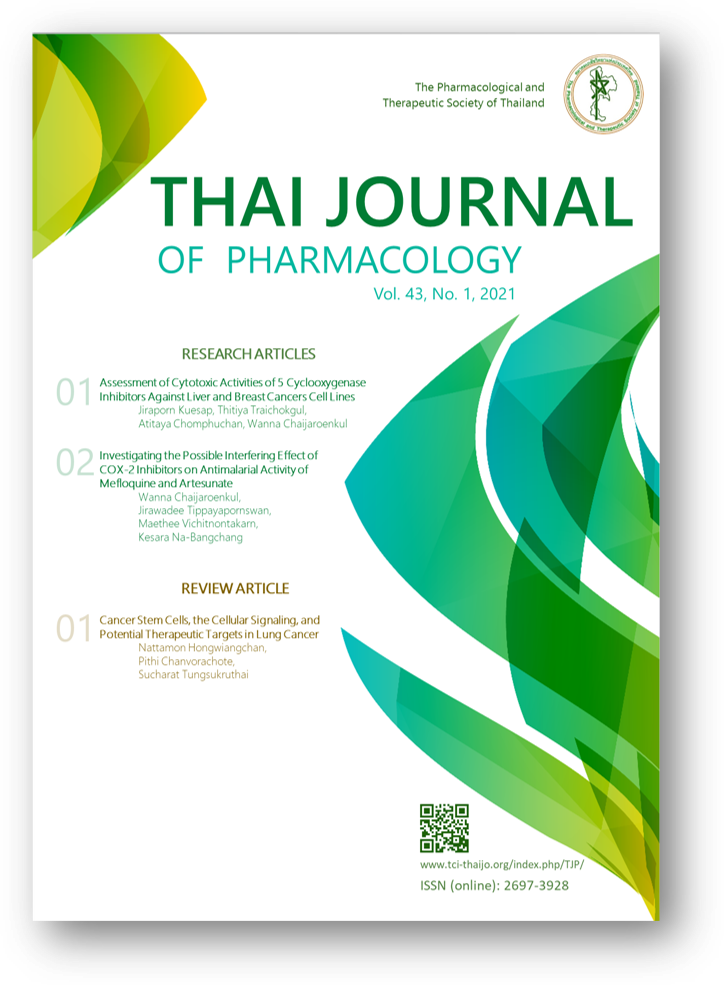Investigating the Possible Interfering Effect of COX-2 Inhibitors on Antimalarial Activity of Mefloquine and Artesunate
Main Article Content
Abstract
Cyclooxygenase (COX) is the key enzyme responsible for the production of prostanoids. It plays important roles in the inflammatory process and pathogenesis of several diseases, including malaria. However, there has been no information of the inhibitory effects of COX inhibitors on inflammatory mediators and standard antimalarial drugs. Therefore, in this study, both selective and non-selective COX-2 inhibitors (aspirin, ibuprofen, piroxicam, and naproxen), alone or in combination, were investigated for their antimalarial activities in vitro. The antimalarial activity was assessed using the SYBR Green I fluorescent-based technique. For mefloquine- aspirin combination, the test wells consisted of mefloquine and aspirin at the ratios of 200:0, 140:30000, 100:50000, 60:70000, and 0:100000 nM. The concentration ratios for artesunate-aspirin were 50:0, 35:30000, 25:50000, 15:70000, and 0:100000 nM. The median (range) concentrations that inhibited parasite growth by 50% (IC50) of aspirin for K1 and 3D7 clones were 1,889 (1,600-2,792) and 2,417 (912-2,630) nM, respectively. The corresponding values of mefloquine were 10.1 (8.1-13.9) and 23.4 (22.9-24.7) nM, respectively. The corresponding values of artesunate were 2.5 (1.6-3.4) vs. 2.2 (1.2-3.2) nM, respectively. The corresponding values for mefloquine were 10 (8-14) and 23 (23-25) nM, respectively. The corresponding values for artesunate were 2.5 (2-3) vs. 2 (1-3) nM, respectively. The IC50 values of ibuprofen, piroxicam and naproxen were higher than 100,000 nM for both clones. The median (range) sum fractional inhibitory concentrations (FIC) of mefloquine-aspirin interaction for K1 and 3D7 P. falciparum clones were 0.82 (0.79-1.0) and 0.97 (0.83-1.1), respectively. The corresponding sum FICs of artesunate-aspirin were 0.94 (0.88-0.95) and 0.95 (0.92-0.97), respectively. Results indicate indifferent antimalarial interaction between these two drugs when used in combination.
Article Details
Upon acceptance of an article, the Pharmacological and Therapeutic Society of Thailand will have exclusive right to publish and distribute the article in all forms and media and grant rights to others. Authors have rights to use and share their own published articles.
References
Anggard E, Matschinsky FM, Samuelsson B. Prostaglandins: enzymatic analysis. Science. 1969 Jan 31;163(3866):479-80.
Dinarello CA, Wolff SM. Pathogenesis of fever in man. N Engl J Med. 1978 Mar16;298(11):607-12.
Goodwin JS, Ceuppens J. Regulation of the immune response by prostaglandins. J Clin Immunol. 1983 Oct;3(4):295-315.
Kilunga KB, Eguchi N, Urade Y, Yamashita K, Mitamura T, Tai K, et al. Plasmodium falciparum produces prostaglandins that are pyrogenic, somno-genic, and immunosuppressive substances in humans. J Exp Med. 1998 Sep 21;188(6):1197-202.
Trager W, Jensen JB. Human malaria parasites in continuous culture. Science. 1976 Aug 20;193(4254):673-5.
Bennett TN, Paguio M, Gligorijevic B, Seudieu C, Kosar AD, Davidson E, et al. Novel, rapid, and inexpensive cell-based quantification of antimalarial drug efficacy. Antimicrob Agents Chemother. 2004 May;48(5):1807-10.
Smilkstein M, Sriwilaijaroen N, Kelly JX, Wilairat P, Riscoe M. Simple and inexpensive fluorescence-based technique for high-throughput antimalarial drug screening. Antimicrob Agents Chemother. 2004 May;48(5):1803-6.
Fivelman QL, Adagu IS, Warhurst DC. Modified fixed-ratio isobologram method for studying in vitro interactions between atovaquone and proguanil or dihydro-artemisinin against drug-resistant strains of Plasmodium falciparum. Antimicrob Agents Chemother. 2004 Nov;48(11):4097-102.
Gupta S, Thapar MM, Wernsdorfer WH, Björkman A. In vitro interactions of artemisinin with atovaquone, quinine, and mefloquine against Plasmodium falciparum. Antimicrob Agents Chemother. 2002; 46:1510-5.
Schwarzer E, Kuhn H, Valente E, Arese P. Malaria-parasitized erythrocytes and hemozoin nonenzymatically generate large amounts of hydroxy fatty acids that inhibit monocyte functions. Blood. 2003 Jan 15;101(2):722-8.
Anyona SB, Hengartner NW, Raballah E, Ong'echa JM, Lauve N, Cheng Q, et al. Cyclooxygenase-2 haplotypes influence the longitudinal risk of malaria and severe malarial anemia in Kenyan children from a holoendemic transmission region. J Hum Genet. 2020 Jan;65(2):99-113.
Anyona SB, Kempaiah P, Raballah E, Davenport GC, Were T, Konah SN, et al. Reduced systemic bicyclo-prostaglandin-E2 and cyclooxygenase-2 gene expression are associated with inefficient erythropoiesis and enhanced uptake of monocytic hemozoin in children with severe malarial anemia. Am J Hematol. 2012 Aug; 87(8):782-9.
Kuesap J, Na-Bangchang K. Possible role of heme oxygenase-1 and prosta-glandins in the pathogenesis of cerebral malaria: heme oxygenase-1 induction by prostaglandin D2 and metabolite by a human astrocyte cell line. Korean J Parasitol. 2010 Mar;48(1):15-21.
Keller CC, Davenport GC, Dickman KR, Hittner JB, Kaplan SS, Weinberg JB, et al. Suppression of prostaglandin E2 by malaria parasite products and anti-pyretics promotes overproduction of tumor necrosis factor-α: association with the pathogenesis of childhood malarial anemia. J Infect Dis. 2006 May 15; 193(10):1384-93.
Perkins DJ, Hittner JB, Mwaikambo ED, Granger DL, Weinberg JB, Anstey NM. Impaired systemic production of prostaglandin E2 in children with cerebral malaria. J Infect Dis. 2005 May 1;191(9):1548-57.
Kunkel SL, Spengler M, May MA, Spengler R, Larrick J, Remick D. Prostaglandin E2 regulates macrophage-derived tumor necrosis factor gene expression. J Biol Chem. 1988 Apr 15;263(11):5380-4.
Renz H, Gong JH, Schmidt A, Nain M, Gemsa D. Release of tumor necrosis factor-alpha from macrophages. Enhancement and suppression are dose-dependently regulated by prostaglandin E2 and cyclic nucleotides. J Immunol. 1988 Oct 1;141(7):2388-93.


